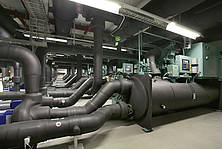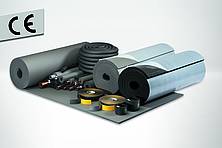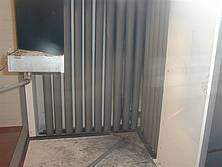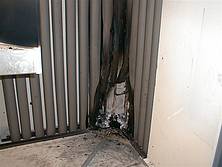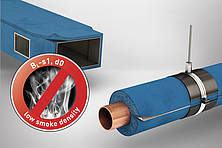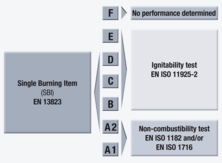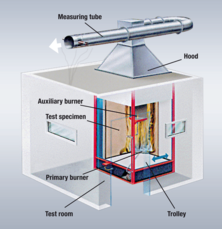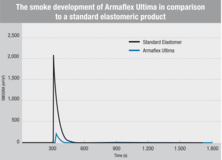By Dipl. Ing. Michaela Störkmann, Armacell Manager Technical Department Europe
Münster, 16 October 2012 - With the introduction of the European product standards and the CE marking of technical insulation materials the national fire classifications have been replaced by European fire classes. After the expiry of the coexistence period on 1 August 2012 it is only permitted to sell technical insulation products which comply with the European product norms and have been tested in accordance with the new European fire classifications. For combustible products the European standards require fire behaviour to be examined in the SBI Test and Small Flame Test. The new fire classification works with the seven fire classes which are already valid in other areas of the construction industry; assessment classes for smoke development and burning droplets have been added to these. In a fire, low smoke density can be of vital importance to allow people trapped and emergency services fast and safe access to escape routes. Therefore, technical insulation materials with low smoke development make a significant contribution to people’s safety in buildings.
The objective of fire protection in buildings is to minimize the risk of a fire and thus protect lives and property. As the official guardian of public safety the state ensures such protection through appropriate legislation. Standards and rules of conduct which are based on recognized technical principles are the means by which the general requirements of fire protection, as defined in law, are put into practice.
In order to limit the speed with which a fire spreads, the use of combustible construction products in buildings is usually restricted. However, it is not possible to forego the use of plastics, for example cables or synthetic insulation materials, completely. The contribution of combustible construction products to the fire load is often overestimated though – compared to the contents of the building (e.g. furnishings), they usually only make up a very small part of the fire load. Furthermore, according to Troitzsch, due to their low density foamed plastics generally only contain 2 – 3 volume per cent of combustible material and thus only constitute a slight fire load in comparison to compact materials [1].
Technical insulation materials must meet many different requirements
Today, it is difficult to imagine the modern building sector without plastics such as flexible elastomeric foams (FEF). Insulation materials on the basis of synthetic rubber have been widely accepted on the market for over 50 years due to their many technical advantages. They have proved themselves both in the insulation of heating and plumbing systems and in cold applications.
Technical insulation materials must reduce energy losses and/or the transmission of structure-borne sound from installations and, in cold applications, reliably prevent condensation on the surfaces of the installations. In addition to these functionally relevant requirements, there are also safety requirements which are decisive when selecting a product: it should be environmentally sound, pose no threat to health and have tested fire behaviour, for example.
When insulation products are developed and enhanced there is often a conflict between the various requirements. For example, the flame retardants used optimize the fire behaviour, but often lead to a considerable deterioration in the insulation properties. What is good for the thermal conductivity of an insulation material can reduce the resistance to water vapour transmission. ‘Sealing the cells’ to improve the µ-factor can, on the other hand, have a negative impact on the fire behaviour. The insula-tion material which is ‘world champion’ in all events has yet to be found. There is currently no non-combustible insulation material which has really optimal installation properties for cold applications, for instance.
Parameters for assessing the reaction to fire
The phase when the fire breaks out is decisive for assessing the fire behaviour of synthetic insulation materials. Troitzsch gives a fundamental description of the fire behaviour of plastics [1].
The characteristic parameters for fire behaviour are:
- Ignitability
- Flame spread
- Heat release (or temperature rise)
- Smoke development
- Burning droplets / falling particles
Parallel to these, phenomena such as toxicity and corrosivity of the fire gases can occur.
To assess and evaluate the reaction to fire, standardized fire tests were developed which are intended to reproduce the fire hazard scenario. The composition of the fire gases is only considered to be rele-vant from the point of view of safety when possibilities to escape are restricted or do not exist (e.g. in rail vehicles which run through tunnels or on ships).
European requirements for technical insulation materials
In the past, many different testing procedures were used in Europe to assess the fire behaviour of construction products and the classifications of technical insulation materials differed greatly in some cases. Now, with the adoption of the product standards for ‘Thermal insulation products for building equipment and industrial installations’, binding, standardized testing procedures and a European fire classification apply in the member states of the European Union.
In order to dismantle barriers to trade within the European Union and facilitate the free movement of goods, the Building Products Directive 89/106/EEC [2], which will be replaced by the Construction Products Regulation 306/2011/EU on 1 July 2013, was introduced with the aim of harmonizing the requirements for construction products throughout Europe. One of the six essential requirements of the Directive concerns fire protection. Building products must fulfil a building material classification which is based on the same testing standards in the whole of Europe. A member state which defines a certain level of safety for a group of building materials should be able to identify the fire properties of a construction product with regard to this level and thus be able to classify it appropriately. The appointed Euroclass is confirmed by a recognized notified body. It is part of the EC Declaration of Conformity which confirms the compliance of insulation materials manufactured according to the harmonized product standards with the European Construction Products Directive. It is documented by the CE marking which is a pre-requisite for being able to market and sell thermal insulation products within the European Union.
The European product standards for insulation materials for building equipment and industrial installations were passed by the national standards organizations in the CEN (Comité Européen de Normalisation) in 2009 and published in the Official Journal of the European Union in June 2010 [3]. Since the expiry of the transition period on 1 August 2012 it is only permitted to sell technical insulation products in the EU countries which comply with the European product standards (and thus with the Construction Products Directive and Construction Products Regulation) and bear the CE mark. The first elastomeric technical insulation materials with the CE mark – such as the ArmaFlex range made by Armacell (see Figure 3) – have been available since the beginning of 2012.
European fire classification of technical insulation materials
A significant reform brought about by the CE certification of technical insulation materials is that the previous national fire classifications have been replaced by European standardized fire classes.
In the past, the classification of the fire behaviour reflected the national safety concept of the country in question. Although similarities in the concepts are discernable, certain aspects of the national ‘fire philosophies’ and test methods were very different. It was not, therefore, possible to make a direct comparison between the different building material classifications of the various countries. In 2000, a new system for classifying the fire behaviour of construction products, the limit values and the applicable testing procedures were introduced in the European Union [4]. The classification standard DIN EN 13501-1 [5] distinguishes fire classes A1, A2, B, C, D, E, F. Table 1 shows the new Euro-classes, the target safety level and their assignment to the previous fire classification under DIN 4102-1 [6].
Table 1: Euroclasses and the target safety level
In order to distinguish the Euroclasses for linear products (such as insulation tubes, for example) from flat products (insulation sheets), the former are marked with a subscripted L (short for linear). So depending on their specific reaction to fire, insulation tubes are classified as BL, CL, DL etc. For many countries tests of smoke development and burning droplets are also new. For this purpose additional classes have been developed which are marked with s (for smoke) and d (for droplets) (see Table 2).
The test methods which must be used to attain the Euroclasses are shown in Figure 4.
Euroclass E is tested in accordance with EN ISO 11 925-2 [6] in the ignitability test. For classes A2 to D additional classification using the SBI test procedure (Single-Burning-Item Test) in accordance with EN 13823 [7] is required.
The ignitability test assesses the ignitability of a construction product by exposing it to a small flame. The SBI test assesses the potential contribution of a construction product to a developing fire in a fire scenario which simulates a single burning item in a room corner close to this construction product (see Figure 5). The test reproduces a realistic fire scenario, which could occur due to a burning waste-paper basket in a corner of the room, for example.
Figure 6 shows the setup of the SBI Test.
For flat products the limit values given in Table 1 of EN 13501-1 are to be used and for linear products the values in Table 3. The limit values for flat products are considerably lower than the classification values for linear products, i.e. more difficult to achieve. The Euroclasses and their limit values were not only defined using the SBI tests, but also verified using large-scale fire tests such as the ISO 9705 Room/Corner (R/C) Test [8]. Apart from confirming that there is an excellent correlation between the test results provided by the two methods, a realistic number and arrangement of the pipes to be insulated was chosen, which led to an equally realistic determination of the classification boundaries.
Depending on the specific composition of the product, in the SBI test elastomeric insulation materials meet the requirements for Euroclass ‘B or C’ (low flammability) or ‘D or E’ (normal flammability). Stan-dard elastomerics tend to have higher smoke development and therefore only achieve an ‘s3’ classifi-cation. On the other hand, elastomeric insulation materials achieve a very good result in the burning droplets / falling particles class, typically ‘d0’. As Figure 5 also clearly shows, elastomerics do not propagate fire.
A characteristic of elastomerics is their high elasticity over a broad temperature range. Their molecular structure is like a three dimensional, wide-meshed net. Due to this cross-linking reaction, also known as vulcanization, elastomerics do not melt, do not propagate the fire and there are no burning droplets.
Elastomeric insulation materials with low smoke development
Like all organic insulation materials, flexible elastomeric foams (FEF) are combustible. In order to ensure that the insulation material is optimally protected against fire, various flame retardants are added [9]. Flame retardants are additives which reduce the ignitability and burning rate through physical and/or chemical action, but do not prevent the materials themselves being combustible. Up to now, organic-based technical insulation materials could only achieve the best construction materials classification for combustible building products with the aid of halogenated systems. Whereas other flame retardants are only effective at relatively low temperatures, halogenated systems act directly in the combustion process at temperatures ranging from 600 to 800 °C. Chloride and bromide are typical ingredients of flame retardants. Brominated flame retardants inhibit combustion very effectively, but due to their mode of action and their effect they lead to high smoke development especially in the gas phase. For this reason, standard elastomeric products achieve a good fire classification in the SBI test – the majority of premium products are classified as ‘B’, i.e. of low flammability – but they tend to have higher smoke development and up to now have at best been classified as ‘s3’. Elastomeric insulation materials with lower smoke development (‘s2’ or even ‘s1’) on the other hand only achieve fire class E or at best D. In practice this means that up to now the user must choose between an insulation material with a good fire classification or with low smoke development.
By taking a completely new approach the insulation manufacturer Armacell has now been able to resolve this conflict of objectives. Due to the development of completely new, intrinsically flame-resistant polymers and using ablative protective additives it is no longer necessary to add any bromi-nated flame retardants. The completely new foam ‘ArmaFlex Ultima’ combines for the first time ex-tremely high flame resistance with minimal smoke development. The blue elastomeric foam is the first flexible insulation material to achieve fire class BL-s1, d0 or B-s2, d0. The innovative Armaprene® Technology has already been patented in the USA (US Patent No. 8,163,811) and the product is pat-ent pending in Europe.
As Figure 8 shows, ArmaFlex Ultima exhibits 10 times less smoke development compared to a stan-dard elastomeric product. The superior fire behaviour of ArmaFlex Ultima is also demonstrated very clearly in a video to be seen on the company’s website at www.armacell.com/ArmaFlexUltima.
Low smoke development can be of vital importance for people trapped in a fire. Because when a fire breaks out escape routes have to be found quickly and that is only possible with minimal smoke development. The fire brigade’s statistics confirm the significance of smoke development for the safety of people in buildings: every year some 600 people die as a result of fires in Germany. But only a few of these are killed by the flames, the majority – 95 % of fire fatalities! – die as a consequence of smoke inhalation. So smoke is a much greater potential hazard than the fire itself.
Many European countries now take this fact into account and have tightened the requirements regarding the smoke development of the building products used.
Summary
With the introduction of the European product standards and the corresponding CE marking for tech-nical insulation materials, the previous national fire classifications have been replaced by European fire classes. The new fire classification works with seven fire classes to which assessment classes for smoke development and burning droplets have been added. In this way the new European fire classification takes into account the fact that low smoke development can be of vital importance in the event of a fire. When introducing the European fire classification many European countries have tightened the legal requirements regarding the smoke development of building products. With the launch of ArmaFlex Ultima Armacell is the only manufacturer of flexible technical insulation materials to provide a closed-cell product with the fire classification BL-s1, d0 or B-s2, d0 with which these requirements can be fulfilled.
Good fire behaviour is only one of the key requirements for technical insulation materials. The products must also have low thermal conductivity and high resistance to water vapour transmission. They should be closed-cell as well as quick and easy to install even under difficult conditions on the building site.
References
[1] Jürgen Troitzsch: Plastics Flammability Handbook - Principles, Regulations, Testing and Approval, 3rd Edition, Carl Hanser Verlag Munich 2004
[2] The Construction Products Directive Council Directive 89/106/EEC of 21 December 1988 on the approximation of laws, regulations and administrative provisions of the Member States relating to construction products; last amended by Regulation (EC) No. 1882/2003 of the European Parliament and of the Council of 29 September 2003
[3] “General Situation of European Standardisation (latest version: Nov. 2009)”, retrieved from: http://www.cen.eu/CEN/sectors/sectors/construction/Pages/default.aspx
[4] Commission decision 2000/147/EC of 8 February 2000 implementing Council Directive 89/106/EEC as regards the classification of the reaction-to-fire performance of construction products
Commission decision of 26 August 2003 amending Decision 2000/147/EC implementing Council Directive 89/106/EEC as regards the classification of the reaction-to-fire performance of construction products
[5] DIN EN 13501-1, Fire classification of construction products and building elements - Part1: Classification using data from reaction to fire tests; German version EN 13501-1:2007+A1:2009
[6] EN ISO 11925-2 “Reaction to fire tests – Ignitability of building products subjected to direct impingement of flame – Part 2: Single-flame source test (ISO 11925-2:2010)”
[7] EN 13823 “Reaction to fire tests for building products. Building products excluding floorings exposed to the thermal attack by a single burning item”
[8] "Development of a common European system for fire testing of pipe insulation based on EN 13823 (SBI) and ISO 9705 (Room/Corner Test)" published as SP Report 2002:21
[9] Dipl. Ing. Michaela Störkmann: “Brandverhalten Elastomerer Dämmstoffe“ (Fire performance of elastomeric insulation materials), in: Isoliertechnik 5/2000, pp. 48 - 55

